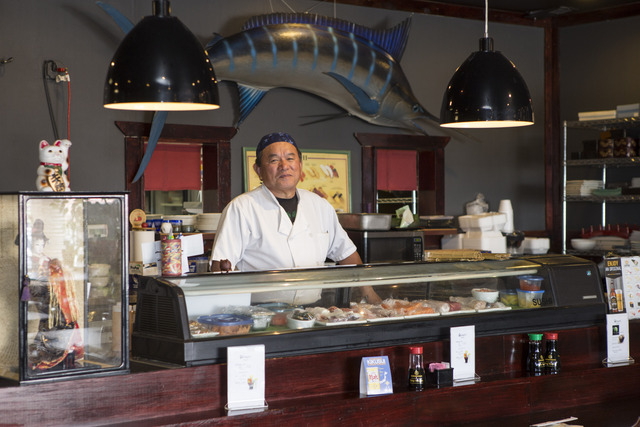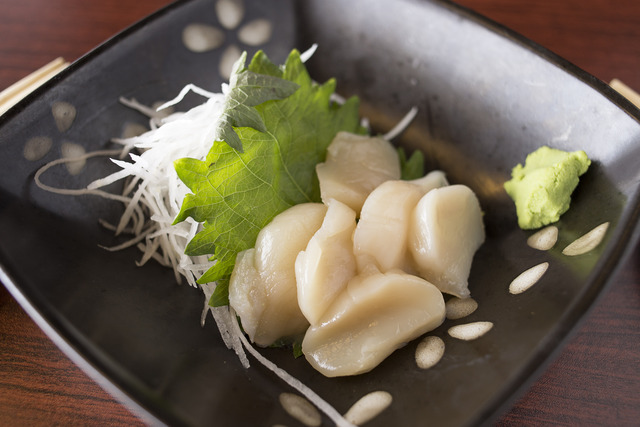There once was a time when going out for sushi implied the eating of Japanese food. Now, restaurants of any Asian inclination are likely to add a sushi bar, and nobody bats an eye. Most Albuquerque sushi is slung at places that serve Chinese, Thai, Lao and Korean food. And of the Japanese-oriented restaurants in town, only a handful are Japanese-owned. At only a year old this May, Nagomi already sits atop this short list.Nagomi inhabits the strip mall space on the corner of Juan Tabo and Menaul, the location of the former Mr. Sushi. The great marlin remains mounted behind the sushi counter. Photographs of iconic Japanese scenes, like the famous Tokyo fish auction, adorn the walls. Soft classical music fills the room. The restaurant was opened by Chef Masa-san, whose cooking I admired when he was at Japanese Kitchen.Nagomi translates roughly to “the feeling of Japanese food.” This bold name is backed up by a large selection of Japanese dishes, some of which I haven’t seen in Albuquerque, including a long list of teishoku set meals. When I first walked in, the specials board included rare treats like black seaweed salad and Japanese scallop sushi. But it was the marinated squid guts that suggested just how serious Nagomi really is about authentic Japanese food. As you might expect from a dish like this, it’s not for beginners. Also known as shiokara, marinated squid guts is a regional delicacy that is sometimes referred to as a chinmi, which means “rare taste,” and is often applied to regional specialties.But at the time, I wasn’t familiar with the importance of chinmi in Japanese cuisine. My thought process consisted of little more than “Marinated squid guts? Sounds awful. I must order it.”It turns out that shiokara, along with many other chinmi, is often consumed while drinking sake. Nagomi has an excellent sake menu, but had I ordered with squid guts in mind, I might have chosen something drier than the unfiltered Perfect Snowflake. This sake, served cold, was sweet, creamy as rice milk, and no match for the flavor of shiokara.It took many sips of Perfect Snowflake to wash away that deep, salty flavor of distilled ocean. Although I couldn’t handle it, I respected it. The presence of such a challenging morsel on the menu filled me with anticipation. I knew that as soon as I excised the taste from my mouth, I was going to review the shit out of this place. And I would start with the shabu-shabu, a kind of DIY hot pot that’s named after the sound made when meat and veggies are simmered in a broth-filled pot atop a tabletop burner. A plate full of thin-sliced beef rib eye, or various pieces of seafood, is delivered, along with a pile of vegetables, udon noodles, and an array of condiments. The soup is ladled into bowls and dressed at your discretion with minced garlic, chile paste, a sesame slurry and ponzu, a soy and citrus-based sauce. The result is delightful and unique. A laminated set of instructions is provided to guide the novice shabu-shabu eater. It advises cooking the proteins first in order to impart their umami to the broth. Then cook the veggies and noodles. The instructions include the cryptic directive to “remove harshness as needed.” I encountered no harshness. I will say, however, that the beef shabu-shabu is greatly superior to the seafood version. If you want fish, there are much better options.The sushi at Nagomi is easily the best I’ve had in town, with many unusual types of fish. The rolls aren’t drenched with squirted-on sauces. Instead they are simple, artful presentations that draw attention to the ingredients themselves, rather than the chef’s tap-dancing abilities.The Japanese scallop, which I had never tried, was an epiphany, with a hint of sweet and a bit more crunch than what you’d encounter in a typical scallop. And the hamachi toro was every bit the buttery paradise as I had expected from the belly of a yellowtail. The poke, chunks of tuna tossed with sesame oil, green onion and chile, and served in a margarita glass was delicate and flavorful. The lobster roll delivered generous chunks of deep-fried tail meat and was flamboyantly served with mock antennae and sections of shell.On the lighter side, the umeshiso maki roll, of pickled plum and shiso leaf, delivered a delicate balance of flavors, rather than the salt bomb I’d tried elsewhere. At Nagomi I finally understood the hype. Another such dish was the Oyako donburi, a curious combination of chicken and egg served on a bowl of rice that had not lived up to expectation elsewhere. At Nagomi the egg was poached, rather than scrambled, and when the yolk was broken it permeated the rice, its creamy richness punctuated by shards of pickled ginger. The tonkotsu ramen was a simple rendition, little more than noodles, meat and broth. But it was the milkiest, most savory pork broth I’d ever tried. Meanwhile, Nagomi’s curry is smooth and buttery, complex and inscrutable, and contrasted sharply by pickled ginger. The curry lubricates and penetrates the rice, humbly demanding your respect as it fills you with the warm fuzzies like only a finely crafted comfort food can.Paradoxically, while Japanese food is characterized by deeply respected and meticulously followed traditions, it also has an experimental side, a willingness to cannibalize and incorporate ingredients and practices from other cuisines. One day at the sushi bar, I realized that Masa-san had done the seemingly impossible: create authentic Japanese cuisine that is tailored to New Mexico. I was eating a mackerel teishoku set and a few rolls. The fried mackerel was buttery and decadent, and each juicy bite gushed with flavor. “It’s Japanese mackerel,” noted Masa-san from behind the sushi bar, as opposed to some two-bit Atlantic fish. One of the side dishes in the teishoku set was a bowl of stewed shishito peppers. Of Japanese origin, shishito peppers have taken hold in northern New Mexico, and patrons of the Santa Fe farmers market will surely recognize them as the little green chiles, pan-fried samples of which are offered every fall. The two rolls before me offered even more flavors of the Southwest.The Green Earth roll was a study in green, with spinach, cucumber, avocado, green chile, green chile sauce and (non-green) tempura shrimp wrapped in green soy paper. After years of searching, this was my first encounter with sushi that successfully incorporated real—meaning roasted—green chile. By contrast, the Ranchero roll was served with a dazzling red chile made of ancho and chipotle peppers, and came with jalapeño and green chile slices on top. I had green chile, red chile, jalapeños, chipotles, anchos and shishitos all within reach, and they blended seamlessly into my Japanese meal.I capped off the meal with a dark sesame ice cream that was musky and sweet. It was a reminder that grace and skill is an effective peacemaker between ingredients that you wouldn’t expect to find together. I couldn’t help thinking that this grace is at the heart of nagomi’s meaning as the feeling of Japanese food.As I ate my chile sushi, I was feeling Japan. I was feeling New Mexico. I was not feeling squid guts. I was drinking a draft sake called Kikusui from a can, and I was feeling really good.
Nagomi Japanese Restaurant
2400 Juan Tabo NE
298-3081
Hours: 11:30am-2:30pm; 5pm-9pm Monday through Thursday 11:30am-2:30pm; 5pm-9:30pm Friday and SaturdayBooze: YesVibe: NagomiThe Alibi recommends: Beef shabu-shabu, grilled mackerel teishoku,hamachi toro sashimi, Japanese scallop, ranchero roll













